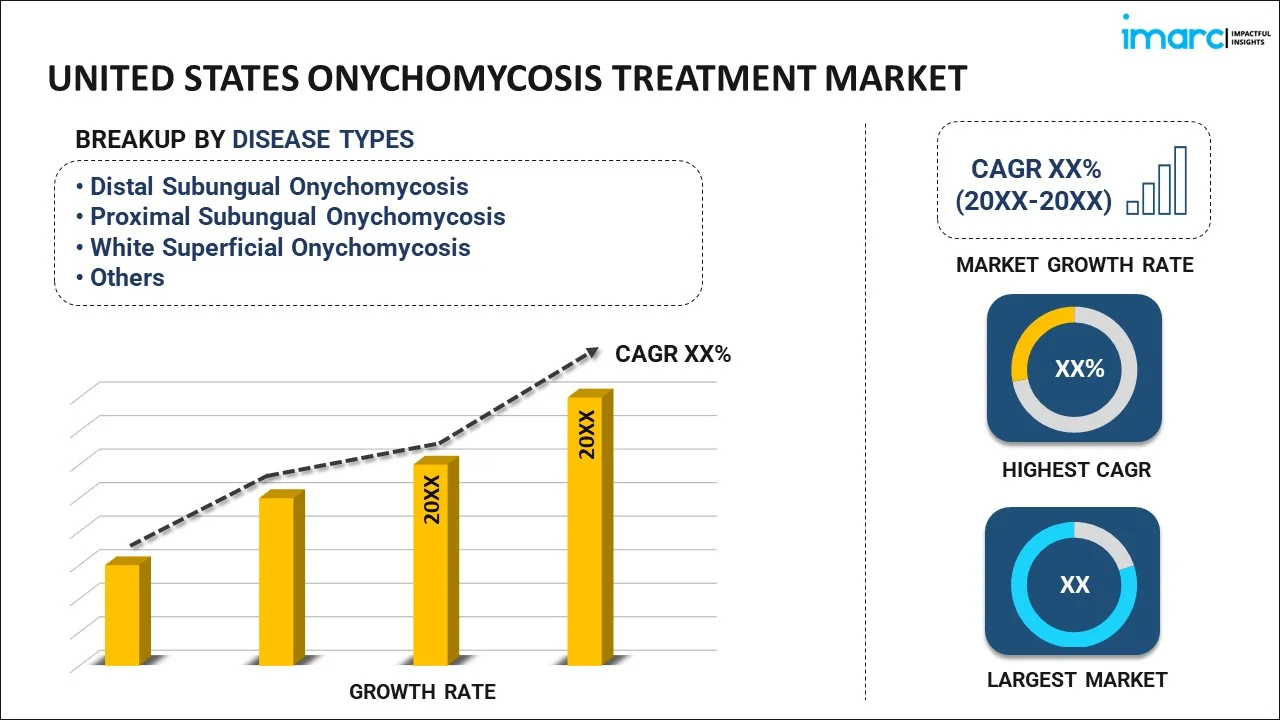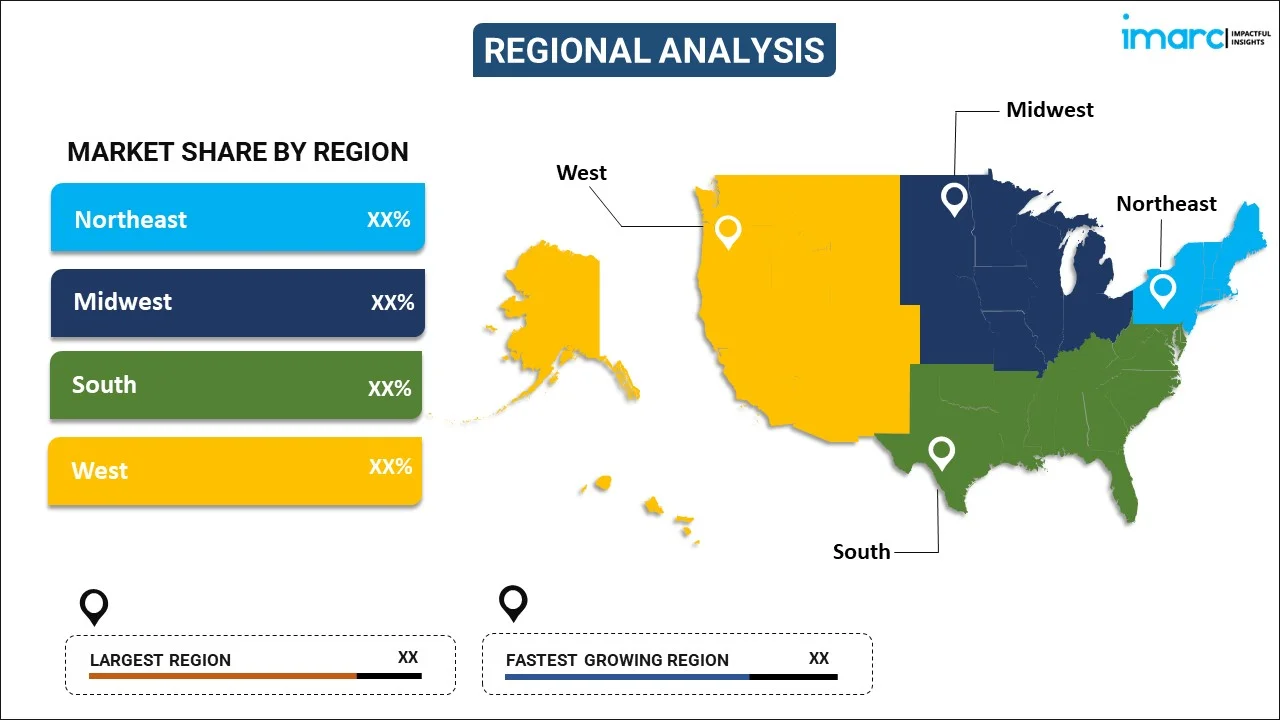
United States Onychomycosis Treatment Market Report by Disease Type (Distal Subungual Onychomycosis, Proximal Subungual Onychomycosis, White Superficial Onychomycosis, Candidal Onychomycosis, and Others), Treatment Type (Laser Therapy, Photodynamic Therapy, Drug Treatment), Drug Class (Allylamine, Azole, Griseofulvin, and Others), Distribution Channel (Hospitals and Clinics, Online Stores, Retail Pharmacies, and Others), and Region 2025-2033
Market Overview:
United States onychomycosis treatment market size reached USD 552 Million in 2024. Looking forward, IMARC Group expects the market to reach USD 865.2 Million by 2033, exhibiting a growth rate (CAGR) of 5.11% during 2025-2033. The increasing innovations in diagnostic tools and technologies for onychomycosis that can enhance the accuracy of diagnosis, leading to better-targeted treatments, are driving the market.
|
Report Attribute
|
Key Statistics
|
|---|---|
|
Base Year
|
2024
|
|
Forecast Years
|
2025-2033
|
|
Historical Years
|
2019-2024
|
|
Market Size in 2024
|
USD 552 Million |
|
Market Forecast in 2033
|
USD 865.2 Million |
| Market Growth Rate 2025-2033 | 5.11% |
United States Onychomycosis Treatment Market Analysis:
- Major Market Drivers: Geriatric population demographics propel higher vulnerability to fungal infections. Advanced diagnostic devices allow for accurate identification and specific treatment methods. Healthcare professionals' increasing awareness allows for earlier intervention strategies. Increasing personal hygiene concern and aesthetic awareness stimulates treatment-seeking. Improved access to different therapeutic modalities bolsters United States onychomycosis treatment market growth.
- Key Market Trends: Movement towards combination therapy regimens consisting of both topical and oral drugs. Incorporation of laser and photodynamic treatments with little side effects. Discovery of new drug delivery systems enhancing efficacy of treatment. Growing demand for patient-friendly treatments. Electronic health solutions facilitating remote monitoring and consultation services market share growth.
- Competitive Landscape: Pharmaceutical firms concentrate on clinical research progress and innovative formulation development. Strategic alliances between manufacturers and healthcare providers increase market extension. Generic manufacturers of drugs increase availability at affordable prices. Dermatology clinics adopt new technologies in treatment. United States onychomycosis treatment market demand influences competitive positioning strategies.
- Challenges and Opportunities: Long treatment time and patient compliance are still major challenges that call for creative solutions. Increasing healthcare expenditure affects the accessibility of treatment for underinsured patients. Prospects lie in the development of fast-acting formulations and targeted medicine strategies. The integration of telehealth demonstrates growth prospects. market analysis identifies untapped rural segments.
Onychomycosis, commonly known as toenail fungus, is a persistent and challenging condition that affects a significant portion of the population. The treatment of onychomycosis is multifaceted, encompassing both topical and systemic approaches. Topical antifungal agents, such as creams and nail lacquers, are frequently employed for milder cases. These formulations typically contain ingredients like amorolfine or ciclopirox, aiming to inhibit the growth of the fungus. However, they may require prolonged and consistent application to achieve desired results. In more severe or resistant cases, oral antifungal medications become the primary course of action. Drugs like terbinafine and itraconazole are commonly prescribed, penetrating the bloodstream to target the infection systemically. While oral medications offer higher success rates, they may come with potential side effects and require close monitoring by healthcare professionals. Additionally, innovative treatments, such as laser therapy, have emerged in recent years, showing promise in selectively targeting the fungus without causing harm to surrounding tissues.
United States Onychomycosis Treatment Market Trends:
Advanced Diagnostic Integration and Tailored Treatment Strategies
The adoption of advanced diagnostics technology is a revolutionary movement in the United States onychomycosis treatment market. Physicians increasingly use molecular diagnostics, dermoscopy, and confocal microscopy to identify fungal species accurately and identify the best course of treatment. This precision medicine strategy allows for clinicians to customize therapies according to pathogen-specific traits, patient demographics, and disease severity. The use of artificial intelligence-based diagnostic equipment improves accuracy levels and minimizes misdiagnosis cases. Digital pathology platforms make remote consultancy easier, increasing access to specialized care in rural and underserved populations. These technological innovations play a major role in enhanced treatment outcomes and patient satisfaction levels. The trend in personalized medicine continues to shape innovation in drug development and clinical practice guidelines. The market growth gains considerably from these advances in diagnosis since precise diagnosis results in better treatment choice and enhanced patient compliance rates.
Combination Therapy Protocols and Multi-Modal Treatment Strategies
Healthcare providers increasingly utilize combination therapy regimes involving several treatment modalities combined for increased therapeutic effectiveness. These holistic treatments often involve the concomitant application of topical antifungal medications with oral therapy, augmented by laser treatment or photodynamic therapy sessions. The synergy of multi-modal management shows improved results over monotherapy regimes, especially in extreme or resistant cases. Clinical evidence lends support to the efficacy of combination therapy between terbinafine oral therapy and ciclopirox topical applications for enhanced fungal clearance. Integration of laser therapy with conventional antifungal therapy offers extra antimicrobial action with fewer systemic side effects. Healthcare practitioners experience enhanced patient satisfaction and shorter treatment durations with the use of formalized combination protocols. The implementation of evidence-based guidelines helps ensure standardized care in various healthcare settings. United States onychomycosis treatment market share increases as such advanced combination methods become increasingly popular among dermatologists and podiatrists across the country.
Emerging Technologies and Novel Drug Delivery Systems
The creation of novel drug delivery systems and novel therapeutic technologies is one important trend redefining treatment models. Nanotechnology-based products increase drug delivery through nail barriers, and bioavailability and therapeutic efficacy are both enhanced. Sustained-release delivery systems decrease dosing frequency needs, enhancing patient compliance and treatment compliance rates. New topical formulations with penetration enhancers exhibit greater penetration across the nail plate than older, traditional preparations. Photodynamic therapy protocols with certain wavelengths and photosensitizers are promising in clinical trials. Applications and cryotherapy methods of plasma therapy provide alternative solutions to patients who are not candidates for standard therapies. Botanical extract and natural compounds research presents potential alternatives with lower side effect profiles. The incorporation of wearable monitoring devices allows real-time tracking of treatment response and compliance monitoring. The market demand rises as such new technologies prove clinical efficacy and gain regulatory clearance for commercial sale.
United States Onychomycosis Treatment Market Segmentation:
IMARC Group provides an analysis of the key trends in each segment of the market, along with forecasts at the country level for 2025-2033. Our report has categorized the market based on disease type, treatment type, drug class, and distribution channel.
Disease Type Insights:

To get more information on this market, Request Sample
- Distal Subungual Onychomycosis
- Proximal Subungual Onychomycosis
- White Superficial Onychomycosis
- Candidal Onychomycosis
- Others
The report has provided a detailed breakup and analysis of the market based on the disease type. This includes distal subungual onychomycosis, proximal subungual onychomycosis, white superficial onychomycosis, candidal onychomycosis, and others.
Treatment Type Insights:
- Laser Therapy
- Photodynamic Therapy
- Drug Treatment
A detailed breakup and analysis of the market based on treatment type have also been provided in the report. This includes laser therapy, photodynamic therapy, and drug treatment.
Drug Class Insights:
- Allylamine
- Azole
- Griseofulvin
- Others
The report has provided a detailed breakup and analysis of the market based on the drug class. This includes allylamine, azole, griseofulvin, and others.
Distribution Channel Insights:
- Hospitals and Clinics
- Online Stores
- Retail Pharmacies
- Others
A detailed breakup and analysis of the market based on distribution channel have also been provided in the report. This includes hospitals and clinics, online stores, retail pharmacies, and others.
Regional Insights:

- Northeast
- Midwest
- South
- West
The report has also provided a comprehensive analysis of all the major regional markets, which include the Northeast, Midwest, South, and West.
Competitive Landscape:
The market research report has also provided a comprehensive analysis of the competitive landscape in the market. Competitive analysis such as market structure, key player positioning, top winning strategies, competitive dashboard, and company evaluation quadrant has been covered in the report. Also, detailed profiles of all major companies have been provided.
Recent News and Developments:
- September 2024: Vanda Pharmaceuticals received FDA clearance for its Investigational New Drug (IND) application for VTR-297, a novel topical antifungal targeting onychomycosis. The therapy, with a unique HDAC inhibitor mechanism, is set to begin U.S. clinical trials, marking a new approach in treating nail fungal infections.
United States Onychomycosis Treatment Market Report Coverage:
| Report Features | Details |
|---|---|
| Base Year of the Analysis | 2024 |
| Historical Period | 2019-2024 |
| Forecast Period | 2025-2033 |
| Units | Million USD |
| Scope of the Report | Exploration of Historical Trends and Market Outlook, Industry Catalysts and Challenges, Segment-Wise Historical and Future Market Assessment:
|
| Disease Types Covered | Distal Subungual Onychomycosis, Proximal Subungual Onychomycosis, White Superficial Onychomycosis, Candidal Onychomycosis, Others |
| Treatment Types Covered | Laser Therapy, Photodynamic Therapy, Drug Treatment |
| Drug Classes Covered | Allylamine, Azole, Griseofulvin, Others |
| Distribution Channels Covered | Hospitals and Clinics, Online Stores, Retail Pharmacies, Others |
| Regions Covered | Northeast, Midwest, South, West |
| Customization Scope | 10% Free Customization |
| Post-Sale Analyst Support | 10-12 Weeks |
| Delivery Format | PDF and Excel through Email (We can also provide the editable version of the report in PPT/Word format on special request) |
Key Benefits for Stakeholders:
- IMARC’s industry report offers a comprehensive quantitative analysis of various market segments, historical and current market trends, market forecasts, and dynamics of the United States onychomycosis treatment market from 2019-2033.
- The research report provides the latest information on the market drivers, challenges, and opportunities in the United States onychomycosis treatment market.
- Porter's five forces analysis assist stakeholders in assessing the impact of new entrants, competitive rivalry, supplier power, buyer power, and the threat of substitution. It helps stakeholders to analyze the level of competition within the United States onychomycosis treatment industry and its attractiveness.
- Competitive landscape allows stakeholders to understand their competitive environment and provides an insight into the current positions of key players in the market.
Key Questions Answered in This Report
The onychomycosis treatment market in United States was valued at USD 552 Million in 2024.
The United States onychomycosis treatment market is projected to exhibit a CAGR of 5.11% during 2025-2033, reaching a value of USD 865.2 Million by 2033.
Key drivers include geriatric population demographics increasing infection susceptibility, advanced diagnostic technologies enabling precise treatment selection, growing aesthetic consciousness promoting early intervention, healthcare provider awareness facilitating diagnosis, innovative drug delivery systems improving efficacy, and expanded insurance coverage enhancing treatment accessibility.
Need more help?
- Speak to our experienced analysts for insights on the current market scenarios.
- Include additional segments and countries to customize the report as per your requirement.
- Gain an unparalleled competitive advantage in your domain by understanding how to utilize the report and positively impacting your operations and revenue.
- For further assistance, please connect with our analysts.
 Request Customization
Request Customization
 Speak to an Analyst
Speak to an Analyst
 Request Brochure
Request Brochure
 Inquire Before Buying
Inquire Before Buying




.webp)




.webp)












